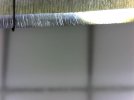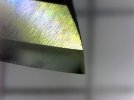- Joined
- May 21, 2020
- Messages
- 180
I'm only going to use edge trailing strokes...Surprised they're using edge leading strokes with that diamond lapping film. I'd have thought that would cut into it, but I guess not.
The BladeForums.com 2024 Traditional Knife is available! Price is $250 ea (shipped within CONUS).
Order here: https://www.bladeforums.com/help/2024-traditional/
I'm only going to use edge trailing strokes...Surprised they're using edge leading strokes with that diamond lapping film. I'd have thought that would cut into it, but I guess not.
I sharpen the Sandrin Torino with a TSPROF clamp style sharpener.Edge trailing might work, but it's definitely not recommended. Tungsten carbide is a sintered mix with usually a cobalt binder. Because of this it cuts fairly easily with diamond abrasive - when sharpening at coarser grits the abrasive mainly pulls tungsten carbide out of the matrix leaving a ragged edge that will be difficult to remedy with finer grit abrasives. The problem using edge trailing is that you stand the chance of pulling an excess of TC particles out of the sintered matrix, as it holds much better with the particles in compression than tension. Once you get to finer grits you might and might not find it such a problem. I sharpen tungsten carbide all the time on a tool and cutter grinder - I never grind with the wheel rotating away from the edge or it will chip and fracture the edge, and that's almost always at a much wider included angle.


Yup, diamonds work just fine...I use DMT for my touch-ups on my Torino.
DMT labels the green extra fine at 9 micron, that's the lowest I ever useSame here.. What grit DMT stone?
Do you use multiple steps?
I may be taking the sharpening too far. (3micron last step)
My expectations of the absolute sharpness might be too high.
Thanks for the reply. : )
Ekretz,
I was trying to error on the side of not overdoing the sharpening.
The knife is 20% cobalt and it is easy to remove material.
It could be that I am stopping short of getting it sharp.
============
Todd Simpson - (science of sharp) sent me an email on the topic:
Dan,
It will be the same as sharpening ceramic, except that only diamond or CBN will work.
It will not form a burr, so you must avoid coarse grits and also no reason to use edge leading strokes.
I do not believe it makes sense to create a keen “shaving” edge on these materials, they get their cutting ability from the broken apex. But if you want to achieve that, you will need diamond strops.
I have no experience with these blades, but I expect resin-bonded diamond will work well.
=============
According to Todd:
1. It will not form a burr
2. Avoid coarse grits
3. The cutting ability comes from the broken apex
My use of the knife bears this out the material feels like it catches on paper when cutting.
The "shaving sharp" edge has thus far been elusive. (it will shave but not at the level of other steels)
I want to use the knife as an EDC box cutter / open the mail utility blade.
A micro serrated edge might be what is needed.
I need a better microscope to see the edge clearly.
The jury is out on the topic for now.
The answers lie in trial and error
or
Having Knife steel nerds \ Todd Simpson \ Sandrin
Take a deep dive into showing how to best sharpen the steel with pictures to back it up.
None of the experts have actually sharpened the Sandrin knives.

Ekertz,
I put a 600 grit edge on my knife last night.
Every other knife in the collection is a better slicer of paper.
The edge tends to snag a little bit.
Cuts cardboard better than a brand new utility razor blade.
Takes 3x the force of my PM2 in K390.
Still cuts very well if handed to a person who has no frame of reference.
The patent reports a preferred binder content of 20-25% cobalt, and a carbide size of
0.6-0.8 microns.
Larrin Thomas has an article on the topic:

Sandrin Carbide - What is it? - Knife Steel Nerds
The cemented carbide materials used in Sandrin's knives is unique and very different from steel. What are the properties of carbide and how does it compare?knifesteelnerds.com
The factory edge might be obtained by "cutting" the carbide with high speed grinding.
Using conventional sharpening by hand might be taking the edges off the carbide.
A high power microscope look at both factory edge and sharpened edge might shed some light on the topic.
Thank you for replying.
Dan

